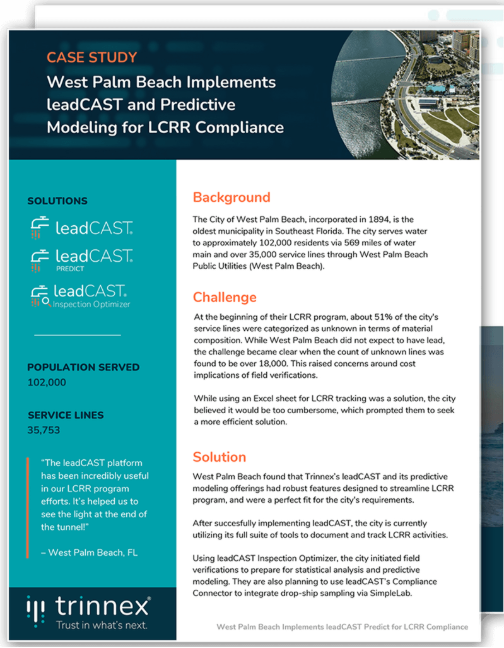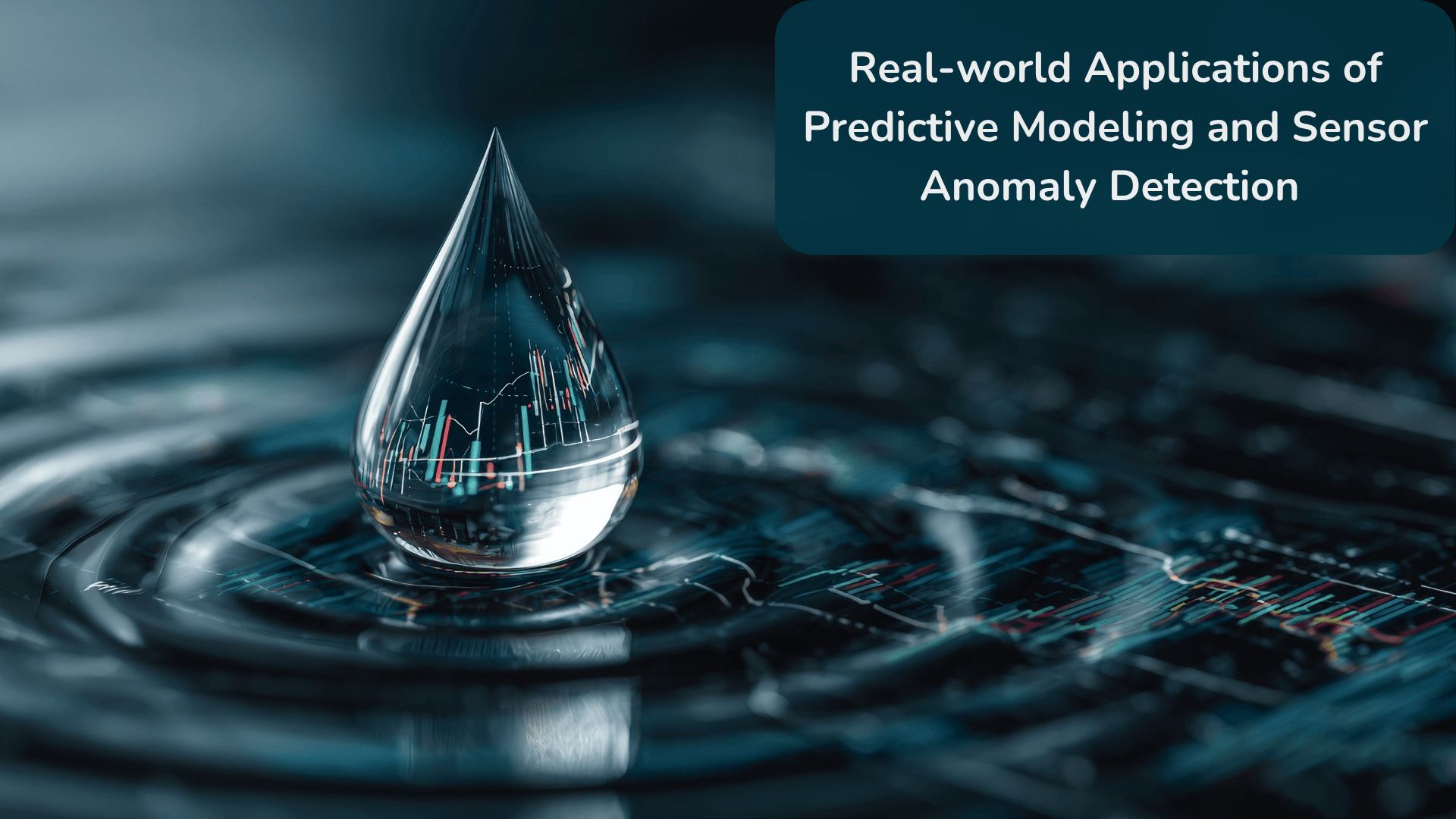Water utilities are under increasing pressure to modernize infrastructure, meet evolving regulations, and stretch limited resources. Utilities face challenges ranging from catastrophic transmission main bursts and damaging flooding to high water loss and rising energy costs. Traditional approaches, such as prioritizing pipe replacement based on age alone or relying on disconnected data systems, can’t keep up with today’s needs. But data science for water utilities can.
At Trinnex, we help utilities unlock the full value of their data. Our solutions transform existing operational data into actionable intelligence without requiring a complete overhaul of your systems. using predictive modeling and sensor anomaly detection. These tools empower teams to anticipate failures, reduce compliance risk, and improve efficiency, without overhauling existing systems. Anomaly detection and predictive modeling are complementary techniques to provide utilities ultimate control for managing their systems. Anomaly detection is an AI-enabled tool to help utilities understand the status quo of their systems, and predictive modeling is an advanced technique based on cutting-edge AI technologies to provide a short and long-term lens on the performance of water systems or assets. For example,
- To anticipate failures, we use predictive modeling that leverages machine learning on your utility's own GIS, hydraulic, and historical data. For our client, this approach was proven to be far superior to age-based methods, identifying the top 10% of their system where 62% of future breaks were likely to occur. We also use advanced sensor analytics to detect issues in near real-time. Our systems can identify damaging patterns that lead to asset failure, creating significant downtime.
- To improve efficiency and reduce costs, our platform has helped utilities achieve a significant reduction in energy usage. For example, our optimization tools can analyze existing SCADA data to find the most efficient pump combinations, reducing energy use and operational costs. These are pure software solutions that leverage data you already have.
Whether you're looking to pilot a focused project, like a leak detection program or an offline savings analysis for network optimization, or you're ready to scale advanced analytics by building a comprehensive Digital Twin of your entire distribution system, we meet you where you are. Let’s explore how these innovations are already making an impact in the field.
What Is Sensor Anomaly Detection, and How Does It Add Value?
Effective sensor anomaly detection requires more than monitoring a single data stream; it demands a holistic, domain-specific approach. An anomaly can only be correctly interpreted by contextualizing data from multiple sensors, such as pressure and flow meters. This system-wide perspective is essential for accurately diagnosing the root cause of an event, which could be anything from a pipe burst to a pump start-up or a change in customer demand.
A critical first step is distinguishing between a true system anomaly and a sensor health issue. Our platform ensures data integrity through a rigorous Quality Assurance/Quality Control process before triggering an alert. This involves constantly monitoring for data gaps, range violations, and "frozen" (flatline) signals. If a faulty signal is detected, the system can use fallback strategies like interpolation or surrogate signals to maintain operational awareness and informs users about sensor issues. Trinnex’s system works similar to a 24/7 subject matter expert that provides insights about the system performance and informs decision makers to take action before it becomes consequential.
We deliver these advanced capabilities through our Data Science-as-a-Service (DSaaS) model. This allows utilities to pilot solutions before committing to a full-scale implementation, making advanced analytics more accessible than ever.
Influent flow monitoring
Understanding your plant's influent is the foundation of efficient wastewater treatment. Trinnex can help wastewater utilities track influent flow to treatment plants. We help utilities transform raw influent flow and pump station data into actionable intelligence. By analyzing SCADA streams from your pumps and flow meters, our analytics identify subtle shifts in performance and patterns that signal emerging operational issues. This is a pure data science in action that leverages data you already have to help you operate your system effectively and catch problems before they become costly.
With this level of insight, you don’t just get alerts - you get the early, validated intelligence needed to take proactive control of your influent conditions.
What Is Predictive Modeling and Why Should Utilities Care?
Predictive modeling for water infrastructure uses historical and real-time data to forecast future issues before they happen. When a predictive model is created, the model includes all types of relevant data such as pipe, historical data such as pipe break, monthly water bills, water quality data at different water systems including distributions and treatment plants to predict factors such as water quality violations, pipe breaks, or water treatment inefficiencies. And the best part? It helps utilities shift from reactive problem-solving to proactive planning. We can showcase the value of predictive modeling for the operation of your utility by experimenting with historical data and using the model to hindcast, nowcast, and forecast the system performance and failures in a fashion that is most suitable for the operation of your utility. As the challenges of each utility are unique, so are the predictive models to address your challenges.
By leveraging machine learning to predict the Probability of Failure (POF) for every pipe, utilities can move beyond simple age metrics. In California, Trinnex built a predictive model that proved far superior to traditional methods, accurately identifying the top 10% of the pipe system that should be replaced based on several socioeconomic and technical factors.
However, a ranked list of high-risk pipes is not an executable capital plan. The critical next step is transforming this risk analysis into actionable projects. Using an optimization algorithm (such as a genetic algorithm or an integer programming model), we group contiguous high-risk pipes into geographically clustered projects of a practical size for construction (e.g., 0.9–1.0 miles). This approach is inherently more cost-effective as it minimizes the repeated mobilization costs associated with replacing scattered, individual pipes. Furthermore, the model incorporates real-world operational constraints, such as avoiding streets with recent or planned paving projects (road moratoriums), ensuring the resulting capital plan is both efficient and practical.
The outcome is a defensible, optimized capital plan that targets the highest-risk assets, maximizes risk reduction, and provides a clear, data-driven foundation for an effective asset management strategy. This shift from reactive fixes to proactive, strategic investment isn't just smarter - it's essential for modern utility management.
How does Predictive modeling help with LCRI Compliance?
leadCAST Predict is our machine learning solution built for Lead and Copper Rule Revisions /Improvement (LCRR/I). It helps utilities identify unknown service line materials using inventory, parcel, and census data.
West Palm Beach, FL, is a real-world example of predictive modeling in action. Facing over 50% of service lines with unknown materials, the city used leadCAST Predict to target field verifications. By focusing on high-probability locations, they cut inspection costs, sped up compliance, and built trust with regulators and the public.
The platform’s transparent, explainable AI builds confidence in every prediction - and gives stakeholders a dashboard they can use.

How Does waterCAST Centralize Utility Data for Analytics?
Today’s utilities manage data across multiple platforms-SCADA, GIS, lab systems, and hydraulic models. Without a single source of truth, important insights fall through the cracks.
That’s where waterCAST comes in. It’s Trinnex’s AI-enabled digital twin platform that centralizes utility data and delivers real-time, predictive insights.
Hartford, CT – The Metropolitan District, is a real-world example of this scenario. The Hartford team uses waterCAST Sewer to compare model predictions with live system data, enabling smarter overflow response, better planning, and more confident decisions. From SSO alerts to sewer capacity forecasting, it’s all in one place. Read more details here.
Additional use cases of waterCAST include:
- Tracking wastewater-based public health trends
- Automating compliance reports
- Coordinating CSO management in real time
- Improving flood emergency plan preparedness
Does DSaaS Work for Utilities of All Sizes?
Not all utilities have a massive IT team or new infrastructure to get started with predictive analytics. That’s why Trinnex offers Data Science-as-a-Service (DSaaS), bringing real-world data science to utilities in a flexible, scalable way. With DSaaS, utilities can start with one focused pilot, validate results with real data, and scale up when they’re ready.
Whether it’s saving money, reducing risk, or improving operations, predictive modeling and sensor anomaly detection deliver measurable benefits including:
- Faster regulatory compliance
- Fewer emergency repairs
- More efficient capital planning
- Improved public health insights
- Lower inspection and energy costs
- Stronger data transparency
- Enhanced cross-department collaboration
From large metros to smaller towns, utilities are turning data into action and seeing the return almost immediately.
How Can Utilities Get Started?
Starting with predictive analytics might feel daunting, but it doesn’t have to be. Here’s how many Trinnex clients begin:
- Identify one pain point (compliance, overflows, data lag, etc.)
- Choose a pilot module through DSaaS or leadCAST/waterCAST
- Review the results and build internal support
- Scale based on success metrics and team capacity
With these steps, utilities can start small, show value, and build confidence as the project progresses. Trinnex can help utilities of all sizes to unlock the value of their data through real-world pilots, explainable AI, and smart digital platforms like leadCAST Predict and waterCAST.
Schedule a tailored walkthrough with us, and we’ll show you how to use your existing systems to make smarter, faster decisions—without unnecessary complexity or cost. Click to connect with us.


